December 27, 2019 – Volume 21, Issue 9
In This Issue
- Flanigan’s Eco-Logic: What a Year!
- Redefining National Progress
- Electrifying Cars and Pick-Ups
- Never-Charge Electric Vehicles
- Free Mass Transit in Kansas City
- Industrial Climate Break-Throughs
- First Commercial Electric Aviation
- Agrivoltaics and Shared Light
- Vermont’s Local Energy Marketplace
- Copenhagen’s Community Fruit Trees
- EcoMotion Team Updates

Flanigan’s EcoLogic: What a Year!
Optimists like me are thrilled with 2019. There has clearly been huge progress in raising awareness about planet care, capped by Time Magazine naming young Greta Thunberg as its Person of the Year. The Climate Crisis as it is now known, is painfully real and understood globally.
Now it’s time for action and more of it from each of us. There are easy steps in each of our homes and daily routines to care for our planet. Often these things save money too. At EcoMotion, we’re pleased to serve businesses and school districts and cities that want to do more to save money and to protect our planet and civilization. The years 2020 to 2030 are now known as the defining decade. Go for it! Let’s roll.
There are so many potent indicators of progress: EcoMotion’s world of solar is exploding in the best ways! Low costs, high demand… lots of trained and talented professionals. Solar is booming and now with storage at its side. This distributed revolution enables new, disruptive utility configurations. EcoMotion is coupling solar and storage to provide carbon-free resiliency solutions, microgrids. Electric vehicles and electric buses are poised to be distributed storage assets adding to this new electricity paradigm. Ancillary power markets are on the horizon as new revenue streams. All this as buildings are electrifying too. Just as we have hybrid cars, we now have hybrid buildings… with net zero highly in vogue!
The news is crackling with announcements of electric cars entering the market. Tesla’s Model 3 has shattered records. According to Car and Driver there are now 16 all-electric EVs in the American market with more on the way from Ford, Mercedes Porsche, Volvo, and others.
How about “never-charge cars?” Thanks to super efficiency solar panels and storage on board, these vehicles such as the Aptera Series 2 can run completely off the grid. There’s even an RV that’s been produced that never needs to refuel. Cut the cord! Not to be outdone, now more and more ferries are electric, and now we can fly electric too! The nation’s first commercial electric aviation commenced in 2019.
Take a look at industry: The Norwegian oil conglomerate, Equinor plans to use offshore wind to power oil rigs. Steel mills in America are going electric. Alcoa has developed a smelting process to produce aluminum that emits pure oxygen, eliminating direct greenhouse gas emissions. The first-of-a-kind metal will be shipped and sold to Apple for its products. Bill Gates made headlines this year with his solar concentrating system that raises temperatures high enough for industry and making cement. Every part of the greenhouse gas emission puzzle is addressed with extraordinary innovation.
Now banks are shifting to sustainability… big time. Money talks. Goldman Sachs announced in December that it will no longer finance new oil drilling or exploration in the Arctic. Environmental concerns spurred its policy, citing “potential impacts to critical natural habitats for endangered species” and the effects on indigenous communities. In response to advocacy efforts by the Gwich’in Steering Committee, the Sierra Club, and the Rainforest Action Network, 13 European and Australian banks have committed to no longer finance new onshore and offshore Arctic drilling.
Just this month the European Investment Bank decided to stop funding most oil and coal projects by 2021… part of a bid to be the world’s first climate bank. Bill McKibben called it a “truly amazing win,” the world’s largest public bank bowing to public pressure. It now recognizes that funding fossil fuels must end. Specifically, the European Investment Bank will not fund any power generation project that creates more than 250 grams of carbon per kWh… effectively banning traditional coal, oil, and gas plants absent carbon capture and storage or combined heat and power to maximize thermodynamic efficiency.
The good news goes on and on. Female world leaders are questioning how to measure their nation’s well-being. It’s not about endless growth. It is about forging a higher quality of life. Coal miner’s kids in Colorado are installing solar panels. A steel mill there is powered by the sun. Wind energy in Iowa has spurred economic development, attracting Good, Facebook, and Microsoft. In Kansas, access to carbon-free wind was key in bringing a Mars plant. The University of California has divested from fossil fuels. And this past week we celebrated the installation of a million solar roofs in California… a goal set by Governor Arnold Schwarzenegger in 2006 that seemed hugely aspirational. Now our sights are on one million, distributed energy storage systems.
2019 has been a year of advances, big and small, profound and incremental. Bring on 2020.
Quote of the Week
“Goldman Sachs is right to recognize that destroying the Arctic Refuge would be bad business….”
Ben Cushing, Sierra Club
Redefining National Progress

Jacinda Ardern, Prime Minister of New Zealand
This year, New Zealand became the first nation in the world to drop Gross Domestic Product (GDP) as its primary measure of economic success. The country has shifted its focus from maximizing GDP to maximizing Well-Being. Now programs and services in New Zealand will be funded and implemented according to their impact on five government priorities: mental health, child well-being, the inequalities of indigenous people, building a nation adapted to the digital age, and fashioning a low-emission economy.
Female prime ministers from Iceland’s Katrin Jakobsdottir, Scotland’s Nicola Sturgeon, and New Zealand’s Jacinda Ardern have joined forces to prioritize a new agenda for well-being of the citizens of these nations. Their policies are bucking the outdated belief system that capitalism and our national economies thrive on endless growth.
Electrifying Cars and Pick-Ups
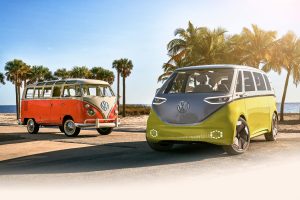
The Classic Volkswagen Mini-Bus, Then and Now!
Iconic cars are going electric: You can now make a reservation for an all-electric Mustang, the Mach-E. It is expected to have 300 miles of range and a starting price of $43,895. And now it’s back and now it’s all-electric: Volkswagen is releasing the “ID Buzz,” a modern, all-electric version of its “hippy” minivan… a symbol of the 60s and 70s. The ID Buzz will be available in 2020 with a 300-mile range. Most manufacturers, plus a cadre of new ones, are developing electric vehicles. Porsche is now releasing its all-electric Taycan models… attempting to rival Tesla’s Model S for luxury and efficiency. The Taycan features 800-volt charging (versus Tesla’s 480) and 250 miles of range in 15 minutes.
Pick-up trucks are considered the most profitable corner of the U.S. auto market. Now automakers are electrifying pick-ups. Tesla is in a big way: Elon Musk is taking on the workhorse heavy pickup market. Beware: Pickup buyers tend to have “fierce brand loyalty.” Many stick with the same brand for life… in many cases what their parents drove. Reportedly, getting a Ford F-150 buyer to switch to a Chevrolet Silverado, much less a Tesla, is like telling him to leave his family! Nevertheless, Tesla’s Cybertruck will be in production in 2021. Announced at the Los Angeles Auto Show, it will cost $39,900 and have a range of 500 miles.
Rivian, a startup based near Detroit, plans to begin production in the second half of 2020 on an electric pickup that starts at $69,000 with a battery range of 400 miles. Rivian will reportedly be able to tow 11,000 pounds, go from zero to sixty in three seconds, and wade in three feet of water. Ford also planning on launching an all-electric pickup truck that is anticipated to be available by the fall of 2022.
Never-Charge Electric Vehicles
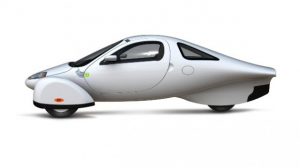
The Apterra 2e
Courtesy Apterra Mortors
The Aptera Series 2 vehicle is arguably the most efficient transportation ever created. The experimental car has a 1,000-mile battery range. It also generates 40 miles a day of range on the free power from its solar panels. It’s aerodynamic; its monocoque is lightweight and strong… and reportedly fun to drive. After having to liquidate in 2012, this innovative start-up is back with a crowdfunding campaign to restart development of its three-wheeled, two seater.
Each owner can reduce his or her carbon footprint by 14,000 ponds of CO2 per year according to Apterra’s CEO Chris Anthony. He combined his knowledge of batteries and wake board manufacture. The lightweight, eco-friendly resin infusion process that would be a perfect fit for lightweight composite structure for vehicles. With Steve Fambro, they developed a new monocoque safety cell structure prototype with two seats and three wheels.
In related news, Toyota, Sharp, and NEDO (New Energy and Industrial Technology Development Organization) have teamed up to test cars equipped with solar panels and batteries such that an electric vehicle can operate indefinitely without plugging in to recharge. For power, it employs advances in thin film technology, 0.03 mm thick solar panels mounted on curved roofs, hoods, and hatchbacks that generate up to 860 watts of power. A new development is that the vehicles will be able to charge when parked, and when in operation. While not yet suited for long-range driving, the technology is advancing driver independence from charging facilities.
Dethleffs is doing something similar, promoting a recreational vehicle (RV) that never needs to be recharged by the grid. Built on an Iveco Daily Electric chassis, clad with solar panels on its roof and sides, the recreational vehicle has 334 square feet of thin film solar panels generating up to 3,000 watts of electricity. Dethleffs 228-Ah sodium-nickel-chloride battery provides 100 miles of range.
Free Mass Transit in Kansas City
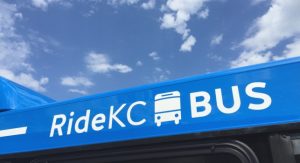 In early December, Kansas City became the first major American city to have fare-free public transit. It’s light-rail system was already free; now council there has voted unanimously to make city bus routes completely free as well. The free service is expected to cost the city about $8 million each year. The resolution was pitched as a major help for low-income residents who rely on transit to commute to work.
In early December, Kansas City became the first major American city to have fare-free public transit. It’s light-rail system was already free; now council there has voted unanimously to make city bus routes completely free as well. The free service is expected to cost the city about $8 million each year. The resolution was pitched as a major help for low-income residents who rely on transit to commute to work.
Public transit has become a focus of political activity in cities across the country as young climate change protestors demand investments in mass transit to help battle climate change. Meanwhile other cities such as Portland, Oregon, are redoubling efforts to crack down on scofflaws and hiring more transit cops to deter free riders. I wish LA would go one way or the other.
Industrial Climate Break-Throughs

The First Batch of Carbon-Free Aluminum
Advancing Aluminum Production
“For more than 130 years, aluminum… has been produced the same way. Four part of bauxite is mined into two parts of alumina, then zapped with lots of electricity to skim off one part of pure aluminum. Currently, aluminum requires about 5% of total U.S. electricity production.
That’s about to change,” according to Lisa Jackson from Apple. She’s referring to the Canadian firm Elysis, a joint venture formed in 2018 with $144 million in funding from Alcoa, Rio Tinto, and the governments of Canada and Quebec. Elysis may transform conventional smelting processes. Its first batch of carbon-free aluminum has proven its concept.
Since 1886, the Hall-Heroult electrolytic reduction process for the manufacture of aluminum has been used. It was consequentially discovered by American Hall and Frenchman Heroult. That led to the first large-scale production plant in 1888 in Pittsburg, later becoming Alcoa. The process involves passing electrical current through a block of carbon called an anode, which burns off and releases CO2 into the atmosphere.
Elysis has developed an “inert-anode smelting technology” that is based on electrolysis and that produces aluminum while emitting no greenhouse gases. Proprietary inert anodes produce only oxygen as a byproduct. The first batches of the carbon-free metal are headed to Apple for use in the housing of its products, iPhones, Apple watches and Macs.
Elysis holds the exclusive right to sell the materials used in the manufacturing the new generation anodes and cathodes, which will last more than 30 times longer than traditional components. The Montreal-based partnership’s goal is to license the technology to the aluminum industry by 2024.
Bill Gates’ Solar Breakthrough
Heliogen, is a clean energy company that professes to be focused on eliminating the need for fossil fuels. That’s lofty. Backed by Bill Gates and others including Patrick Soon-Shiong of Nant Energy, Heliogen emerged from stealth mode this past month, claiming to have discovered a new way to use artificial intelligence and a field of mirrors to direct and concentrate enough sunlight to generate extreme heat. While concentrating solar systems have been proven for electricity generation, Heliogen is an industrial solution… proving that concentrated solar heat at 1,000 degrees Celsius can be used to create cement, glass, steel, and to energize other industrial processes.
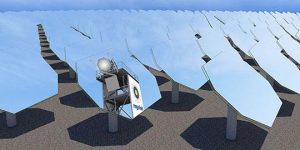
The HelioMax System
Graphic image courtesy of Heliogen
Imagine a pie chart of global greenhouse gas emissions. The production of cement and steel are responsible for more than a fifth of the pie. In the past, solar concentrators have not attained high enough temperatures to make cement and steel. Now Heliogen’s carbon-free, solar power can be used to replace fossil fuels in a carbon intensive industry that that has been untouched by the clean energy resolution. Heliogen is also backed by billionaire Los Angeles Times and Nant Energy owner.
The company plans to offer different services, HelioHeat and HelioFuel. Heliogen — a play on the word helio – sun, and generation, has its sights set on using the heat to split water into hydrogen creating fuels to complement its industrial processes.
Steel Mills Powered by Wind and Solar
For decades access to cheap coal-fired electricity fueled industrial expansion across the midwest, from auto plants to steel mills. Now cheap wind power is changing that equation: A $250 million Nucor Corp “micro” mill taking shape in Sedalia, Missouri will be the first to steel mill that will run on wind power.
Steel mills have been responsible for ~7% of us GHG emissions according to Mighty Earth in its report “Cold Steel Hot Climate.” The Nucor mill will be powered through a 75 MW Power Purchase Agreement between Nucor and Evergy. The utility will bring a new wind farm on line to serve the mill where high efficiency electric arc furnaces will melt recycled scrap and convert it into steel rebar.
In related news, Colorado is home to the first sun-powered steel mill. The mill is powered by a 240 MW solar project that was developed by Lightsource.
First Commercial Electric Aviation

Electric de Havilland Beaver
Courtesy Harbour Air Seaplanes
In December, aviation history was made as the first commercial airline flight with paying passengers took off and landed… using an all-electric motor! The Harbor Air plane is a retrofitted de Havilland Canada Beaver. If lifted off from Vancouver Harbour… signaling aviation’s future when the startup MagniX’s Magni500 electric motor powered the Beaver into the air.
MagniX’s smaller engines – the Magni250 — will power Israel-based Eviation Alice aircraft. Specifically designed to be electric powered, the Alice holds nine passengers. At the Paris Air Show this past June, Cape Air from Massachusetts placed the first firm order for the Alice, a plane expected to fly in 2020 and be available for commercial service in 2022. It is expected to have a range of 600 miles, six times the retrofitted Beaver’s 100-mile range.
Pound for pound, batteries pack far less energy than aviation fuel; the latter has 40 times as much energy. Batteries relatively low power densities remains the limiting factor in their use for aviation. Hybrids may be the interim step, preceding all-electric jetliners. Airbus is considering offering a hybrid option for is single-aisle A 320. Boeing is pursuing hybrid as well.
In the meantime, all-electric options for short hauls may well make sense. All electric planes like the Alice promise to slash operating costs; they are 60 – 80% cheaper to operate than fossil-fuel aircraft. While a 100-mile flight in a Cessna Caravan would cost ~$300 in fuel, it would require only $6 – 12 of electricity. Maintenance costs are lower for electric motors as well.
Agrivoltaics and Shared Light
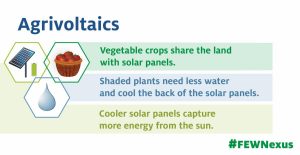
The Food Energy Water Nexus
Agrivoltaics, also known as agrophotovoltaics (APV) is the process of co-developing the same area of land for both solar power and agriculture. The technique was originally conceived by Adolf Goetzberger and Armin Zastrow in 1981. They came up with the idea of sharing light between two types of production. Agrivoltaics has been implemented in Japan since 2004. The practice has expanded into Asia and Europe. Several crops can benefit, including fruit production.
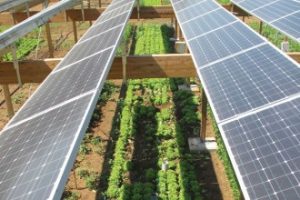
Agrivoltaics: Image Courtesy of Conservation Magazine
A feature of agrivoltaics is that “demountable” structures have been developed so that farmers can move solar arrays based on crop rotations and farming needs. Japanese farmers cultivate ginseng, ashitaba, and coriander. In China, Panda Green Energy installed panels over a vineyard. In the United States, U.C. Davis researchers are conducting agrivoltaic experiments with crops including alfalfa, sorghum, lettuce, spinach, beets, carrots, chard, radishes, potatoes, arugula, mint, turnips, kale, parsley, coriander, beans, peas, shallots, and mustard.
Vermont’s Local Energy Marketplace

The Vermont Green Attributes Program
Offered by Green Mountain Power; Delivered by LO3
Imagine one homeowner being able to sell excess electricity to a neighbor. A Vermont experiment is enabling this. LO3, a firm headed up by Lawrence Orsini, has developed a program for Green Mountain Power (GMP) that allows Vermonters to sell renewables to businesses. Called Vermont Green, the pilot project – app-based and simple for participants — enables transactions between homeowners that are willing to sell their output and businesses that want more renewables.
The test program has begun and will be open initially to 50 businesses and 150 households. The participants will trade a kind of local renewable energy credit (REC) that the utility is calling Vermont Green Attributes. Here’s how it works: Each day the businesses will log into the platform developed by LO3. They will then bid in a price for the attributes. Homeowners can then provide the amount of attributes they are willing to sell for the bid price.
The trades are transparent to the participants. Green Mountain Power handles the billing and compensates the households. A 5% transaction fee is placed on the seller to pay GMP admin fees. If the households cannot provide enough renewable power for the businesses, the utility will make up the difference from its wind and “cow-power” assets.
Vermont’s power system is already ~ 60% green. Vermont Green helps businesses that want to be 100% green without the complexity of a power purchase agreement. GMP’s customers report difficulties going green, that current REC options are not appealing, that there is inflexibility of entering into long-term agreements, there are hassles locating and working with trusted brokers, and that the question of RECs’ origins looms large. Vermont Green is a business proposition that makes clear the source of its green power.
GMP chose LO3 from six transactive energy vendors. LO3 is best known for its use of block chain technology in the Brooklyn Microgrid Project. Block chain verifies the payment and the chain of custody of renewable energy attributes. GMP believes the backbone formed by the local energy marketplace can someday involve energy storage, electric vehicle charging, and thermostatically controlled loads or carbon offsets. LO3 is developing a platform feature that will allow a buyer of attributes to specify which town they are from to help strengthen connections and economic activity within local communities.
Copenhagen’s Community Fruit Trees

A Glorious June Day in Copenhagen
Copenhagen’s city council recently voted to plant public fruit trees, including blackberry bushes and apple trees, in a variety of public green spaces – playgrounds, cemeteries, churchyards, parks, spots facilities. The council decision marks an effort to reconnect people with local flora and food.
There is a long tradition of local foraging in Denmark, with laws on the books dating back the Middle Ages that allow citizens to harvest food from public lands. People have also been permitted to harvest from private lands as long as they remained on footpaths. The Danish capital is expanding this tradition into urban spaces. Vild Mad is a free mobile app that educates people about the foraging there… rich with guided tours and recipes.
EcoMotion Team Updates
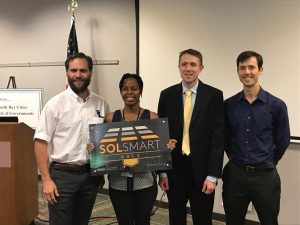
Shaun Celebrates SolSmart Gold Designation with Officials from The City of Torrance, The Solar Foundation, and the Cadmus Group
Alizeh Siddiqui
In November, Alizeh Siddiqui joined the EcoMotion team as Project Manager. Her primary responsibility is supporting EcoMotion’s contract to establish an Office of Sustainability for the City of Glendale. She is a native of Mississippi and Summa Cum Laude graduate of the University of Mississippi, home of the Ole Miss Rebels.

Prior to joining the EcoMotion team, Alizeh worked in publishing for Thomas Reuters in Sydney, Australia and then remotely as a marketing specialist for Innovarge LLC, a Pakistani import/export firm. In addition to Spanish proficiency, she is fluent in Urdu and Hindi. A warm and talented communicator with strong interests in policy, she has already shined with skills and enthusiasm now for the benefit of EcoMotion’s projects and clients.
